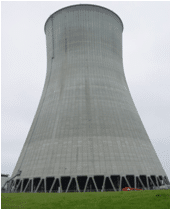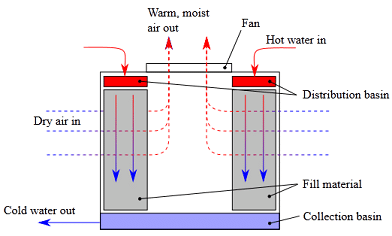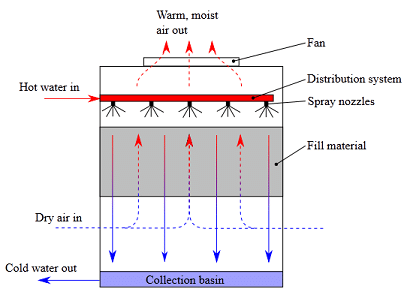Cooling Tower Fundamentals: Cooling Tower Types
All cooling towers are designed to remove waste heat from water and transfer it to the atmosphere, but there are a lot of ways to accomplish this task. Cooling towers can be categorized in a number of different ways, because there are so many differences between cooling towers. For our purposes, we will cover three kinds of cooling towers based on how air and water flow (counterflow, crossflow, and hyperbolic) and two types based on how the air is moved (mechanical and natural draft).
Counterflow and Crossflow
Crossflow towers utilize a type of splash fill media through which the incoming air flows horizontally across the downward flow of water from the top distribution basins. Crossflow towers tend to have lower initial and long-term costs, and are often easier to maintain. Crossflow designs are more prone to freezing, however.
In counterflow towers the incoming air moves vertically upward through the fill, while the water flows downward from the distribution system. Counterflow towers tend to be more compact, but have a higher initial and operating costs because of the added power needed to force the air in opposition to the water flow.
Hyperbolic
Hyperbolic towers are structurally strong and use a minimum of materials, while handling large projects like nuclear or coal-fired power plants. Hyperbolic towers operate through a chimney, or stack, effect; when the air outside the cooling tower is cooler than the air inside the tower, the air outside forces the humid, inside air to travel upwards. Fill is placed around the lower portion of the tower, water is sprayed over it, and the water is cooled by the natural draft of the air moving up through the tower.
Mechanical and Natural Draft Cooling Towers
Mechanical draft towers utilize some method of mechanical force, such as a fan, to move air through the tower. Mechanical draft towers can either push air into, blow thru, or pull air out, draw thru, of the tower.
Natural draft towers utilized the buoyancy of the warm air combined with a tall chimney to naturally draw air through the tower.
Both mechanical and natural draft towers can employ either counterflow or crossflow water and air movement methods. All hyperbolic cooling towers, however, are natural draft towers.

















